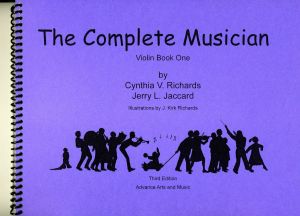The Complete Musician
The only Kodály-based string curriculum I knew of was Colourstrings out of Finland, and so I went to a workshop in Helsinki led by Geza Szilvay, its founder. He and his brother were brought up in Hungary, moved to Finland and have had 40+ years of experience developing their approach. Their Helsinki Strings have become renowned performers. Colourstrings is also strong in Great Britain and Australia. Even though there was an attempt made to introduce it to the American string community, it didn’t really succeed, possibly because it was expensive and people didn’t understand how it worked. Also, their folk songs are not our folk songs. American children need American songs for their study material (a mandatory principle of Kodály’s work).
I learned much and began developing a curriculum of my own. In collaboration with my colleague Dr. Jerry L. Jaccard (prominent in the international Kodály community) over the past 15 years or so, we have developed a string curriculum that follows singing musicianship curriculum principles common to most North American Kodály-based programs. It is called The Complete Musician (Third Edition). At present there are books in three levels for violin, viola and cello. Book 4, the study of major keys and key signatures, and Book 5, the study of minor keys and key signatures, are under construction.
The first 3 levels are designed for the private studio and homogeneous classes (classes of like instruments). By the time the students have finished the first three levels, they know all the basic finger patterns as they relate to solfege and the moveable do. Rhythmic and melodic elements are taught one at a time through short, singable tunes. Students have learned the names of all the notes on the staff in first position. Shifting activities acquaint the students with the whole fingerboard from the very beginning, preparing them for later shifting studies which require more advanced reading skills. Part work is introduced sequentially through the use of ostinato, canon, and composed duet, providing the instrumental class with material to develop the students’ ensemble skills.
Books 4 and 5 are designed for either same instruments or mixed instruments. Each key signature is introduced with a sound to sight learning segment from which students write a two- octave scale in the key. The notes of the key are then reinforced with song, dance, canons, solos with piano accompaniment, duets and trios. The transition from singable music to instrumental music is smooth, keeping concepts of tonal structure clear. Eighteenth century dance forms are introduced. More complex rhythms, varied bowing styles including spiccato, and more shifting prepare students for intermediate level performing.
I have found this learning sequence to be effective in preparing students to become knowledgeable musicians. They have the foundation necessary to understand discussions of musical structure and style.

